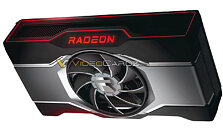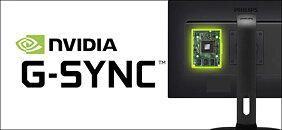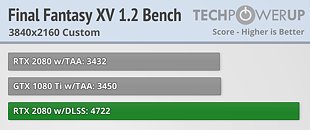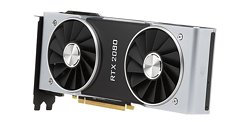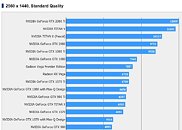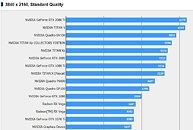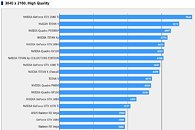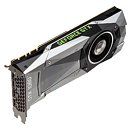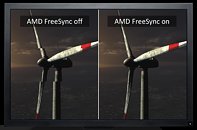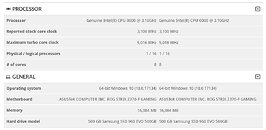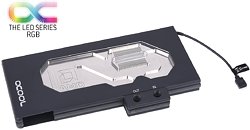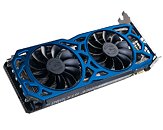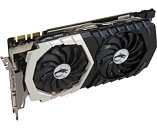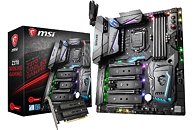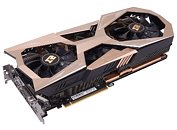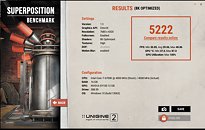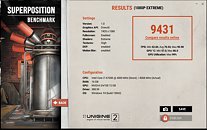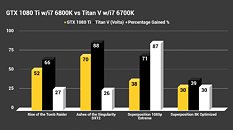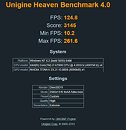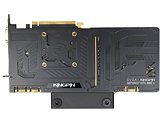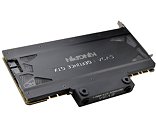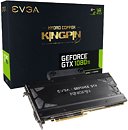Apr 24th, 2025 18:10 EDT
change timezone
Latest GPU Drivers
New Forum Posts
- What are you playing? (23458)
- random system shutdown with fans running at full speed (59)
- Choosing an Internal HDD (15)
- Waterloop 24/7 or no? (21)
- Your PC ATM (35361)
- I dont understand the phone OS world..... (47)
- I tried to use AMD Auto Overclock, and now my PC has been freezing up sometimes. Afterwards, the screen goes black or displays artifacts. (26)
- RX 9000 series GPU Owners Club (513)
- New GPU 5070 Ti or better CPU Ryzen7 7800X3D ? (27)
- Cracks in my cpu waterblock should I be concerned? (12)
Popular Reviews
- NVIDIA GeForce RTX 5060 Ti 8 GB Review - So Many Compromises
- Colorful iGame B860M Ultra V20 Review
- Crucial CUDIMM DDR5-6400 128 GB CL52 Review
- ASUS GeForce RTX 5060 Ti TUF OC 16 GB Review
- ASRock X870E Taichi Lite Review
- Upcoming Hardware Launches 2025 (Updated Apr 2025)
- Sapphire Radeon RX 9070 XT Pulse Review
- Sapphire Radeon RX 9070 XT Nitro+ Review - Beating NVIDIA
- AMD Ryzen 7 9800X3D Review - The Best Gaming Processor
- NVIDIA GeForce RTX 5060 Ti PCI-Express x8 Scaling
Controversial News Posts
- NVIDIA GeForce RTX 5060 Ti 16 GB SKU Likely Launching at $499, According to Supply Chain Leak (182)
- NVIDIA Sends MSRP Numbers to Partners: GeForce RTX 5060 Ti 8 GB at $379, RTX 5060 Ti 16 GB at $429 (127)
- NVIDIA Launches GeForce RTX 5060 Series, Beginning with RTX 5060 Ti This Week (115)
- Nintendo Confirms That Switch 2 Joy-Cons Will Not Utilize Hall Effect Stick Technology (105)
- Nintendo Switch 2 Launches June 5 at $449.99 with New Hardware and Games (99)
- Sony Increases the PS5 Pricing in EMEA and ANZ by Around 25 Percent (85)
- NVIDIA PhysX and Flow Made Fully Open-Source (77)
- Windows Notepad Gets Microsoft Copilot Integration (75)
News Posts matching #GTX 1080 Ti
Return to Keyword BrowsingPSA: Alan Wake II Runs on Older GPUs, Mesh Shaders not Required
"Alan Wake II," released earlier this week, is the latest third person action adventure loaded with psychological thriller elements that call back to some of the best works of Remedy Entertainment, including "Control," "Max Payne 2," and "Alan Wake." It's also a visual feast as our performance review of the game should show you, leveraging the full spectrum of the DirectX 12 Ultimate feature-set. In the run up to the release, when Remedy put out the system requirements lists for "Alan Wake II" with clear segregation for experiences with ray tracing and without; what wasn't clear was just how much the game depended on hardware support for mesh shaders, which is why its bare minimum list called for at least an NVIDIA RTX 2060 "Turing," or at least an AMD RX 6600 XT RDNA2, both of which are DirectX 12 Ultimate GPUs with hardware mesh shaders support.
There was some confusion among gaming online forums over the requirement for hardware mesh shaders. Many people assumed that the game will not work on GPUs without mesh shader support, locking out lots of gamers. Through the course of our testing for our performance review, we learned that while it is true that "Alan Wake II" relies on hardware support for mesh shaders, the lack of this does not break gameplay. You will, however, pay a heavy performance penalty on GPUs that lack hardware mesh shader support. On such GPUs, the game is designed to show users a warning dialog box that their GPU lacks mesh shader support (screenshot below), but you can choose to ignore this warning, and go ahead to play the game. The game considers mesh shaders a "recommended GPU feature," and not a requirement. Without mesh shaders, you can expect a severe performance loss that is best illustrated with the AMD Radeon RX 5700 XT based on the RDNA architecture, which lacks hardware mesh shaders.
There was some confusion among gaming online forums over the requirement for hardware mesh shaders. Many people assumed that the game will not work on GPUs without mesh shader support, locking out lots of gamers. Through the course of our testing for our performance review, we learned that while it is true that "Alan Wake II" relies on hardware support for mesh shaders, the lack of this does not break gameplay. You will, however, pay a heavy performance penalty on GPUs that lack hardware mesh shader support. On such GPUs, the game is designed to show users a warning dialog box that their GPU lacks mesh shader support (screenshot below), but you can choose to ignore this warning, and go ahead to play the game. The game considers mesh shaders a "recommended GPU feature," and not a requirement. Without mesh shaders, you can expect a severe performance loss that is best illustrated with the AMD Radeon RX 5700 XT based on the RDNA architecture, which lacks hardware mesh shaders.

AMD Radeon RX 6600 XT Arrives this August
AMD is allegedly preparing for an August 2021 debut of its Radeon RX 6600 XT graphics card in the retail segment, according to tech YouTuber Coreteks. Released exclusively as custom-design cards, through the company's AIB partners, the card will reportedly come with an MSRP price of USD $399, or roughly $100 less than that of the RX 6700 XT (which is being scalped for north of $800). The lack of a reference-design (MBA) model in the retail channel means that the card will not be sold through the AMD website.
The Radeon RX 6600 XT will reportedly be based on the 7 nm "Navi 23" silicon, although it remains to be seen if it maxes the silicon out. 8 GB will be the standard memory amount, across a 128-bit wide GDDR6 memory interface, cushioned by a 32 MB Infinity Cache. As for performance, Coreteks predicts that the RX 6600 XT will perform ±5% of the RX 5700 XT and the GTX 1080 Ti, which could make it a formidable card for AAA gaming at 1080p, or at 1440p with FSR.
The Radeon RX 6600 XT will reportedly be based on the 7 nm "Navi 23" silicon, although it remains to be seen if it maxes the silicon out. 8 GB will be the standard memory amount, across a 128-bit wide GDDR6 memory interface, cushioned by a 32 MB Infinity Cache. As for performance, Coreteks predicts that the RX 6600 XT will perform ±5% of the RX 5700 XT and the GTX 1080 Ti, which could make it a formidable card for AAA gaming at 1080p, or at 1440p with FSR.

NVIDIA Releases GeForce 461.09 WHQL Drivers
NVIDIA today released GeForce 461.09 WHQL drivers. The drivers do not appear to include any day-one game optimization, but features an important security update, and a handful fixes. With this release NVIDIA also identified an interesting issue to fix in a future driver update. Apparently, GPUs based on the "Turing" and "Ampere" graphics architectures exhibit increased idle power consumption on machines with certain higher refresh-rate G-SYNC monitors.
Among the fixes with GeForce 461.09 WHQL are a bug that caused an FPS counter to appear on Windows Mail and Calendar apps; a BSOD noticed on GeForce GTX 750 Ti; system freezing to solid color and screen-flickering noticed on the GTX 1080 Ti, improper HDR implementation when connected to certain LG OLED TV models; and a BSOD known to occur when waking up machines from sleep that have three 4K UHD monitors plugged in. Grab the drivers from the link below.
DOWNLOAD: NVIDIA GeForce 461.09 WHQL
Among the fixes with GeForce 461.09 WHQL are a bug that caused an FPS counter to appear on Windows Mail and Calendar apps; a BSOD noticed on GeForce GTX 750 Ti; system freezing to solid color and screen-flickering noticed on the GTX 1080 Ti, improper HDR implementation when connected to certain LG OLED TV models; and a BSOD known to occur when waking up machines from sleep that have three 4K UHD monitors plugged in. Grab the drivers from the link below.
DOWNLOAD: NVIDIA GeForce 461.09 WHQL

NVIDIA Extends DirectX Raytracing (DXR) Support to Many GeForce GTX GPUs
NVIDIA today announced that it is extending DXR (DirectX Raytracing) support to several GeForce GTX graphics models beyond its GeForce RTX series. These include the GTX 1660 Ti, GTX 1660, GTX 1080 Ti, GTX 1080, GTX 1070 Ti, GTX 1070, and GTX 1060 6 GB. The GTX 1060 3 GB and lower "Pascal" models don't support DXR, nor do older generations of NVIDIA GPUs. NVIDIA has implemented real-time raytracing on GPUs without specialized components such as RT cores or tensor cores, by essentially implementing the rendering path through shaders, in this case, CUDA cores. DXR support will be added through a new GeForce graphics driver later today.
The GPU's CUDA cores now have to calculate BVR, intersection, reflection, and refraction. The GTX 16-series chips have an edge over "Pascal" despite lacking RT cores, as the "Turing" CUDA cores support concurrent INT and FP execution, allowing more work to be done per clock. NVIDIA in a detailed presentation listed out the kinds of real-time ray-tracing effects available by the DXR API, namely reflections, shadows, advanced reflections and shadows, ambient occlusion, global illumination (unbaked), and combinations of these. The company put out detailed performance numbers for a selection of GTX 10-series and GTX 16-series GPUs, and compared them to RTX 20-series SKUs that have specialized hardware for DXR.Update: Article updated with additional test data from NVIDIA.
The GPU's CUDA cores now have to calculate BVR, intersection, reflection, and refraction. The GTX 16-series chips have an edge over "Pascal" despite lacking RT cores, as the "Turing" CUDA cores support concurrent INT and FP execution, allowing more work to be done per clock. NVIDIA in a detailed presentation listed out the kinds of real-time ray-tracing effects available by the DXR API, namely reflections, shadows, advanced reflections and shadows, ambient occlusion, global illumination (unbaked), and combinations of these. The company put out detailed performance numbers for a selection of GTX 10-series and GTX 16-series GPUs, and compared them to RTX 20-series SKUs that have specialized hardware for DXR.Update: Article updated with additional test data from NVIDIA.
Final Fantasy XV Benchmark Gets DLSS Update, GeForce RTX 2080 Performance Tested
Square Enix has just updated their Final Fantasy XV Benchmark to version 1.2, adding support for NVIDIA's DLSS (Deep Learning Super-Sampling) technology. The new release will still allow users to test any graphics card(s) they have just as it did before. That said, owners of NVIDIA's RTX 2070, 2080, and 2080 Ti get the benefit of having access to DLSS for improved image quality and performance. NVIDIA claims that performance will improve by up to 38% with DLSS alone. In order to verify that we ran a few tests of our own to find out.
Preliminary testing was done using Corsair's Vengeance 5180 Gaming PC, which is equipped with an Intel i7-8700, 16 GB 2666 MHz DDR4 and an NVIDIA GeForce RTX 2080. At 3840x2160 with the highest possible settings, DLSS offered a 36% increase in performance. This is very close to NVIDIA's specified increase and within the expected margin of error. When compared to the older GTX 1080 Ti which was paired with a stock Intel i7-8700K, and 32 GB of 3466 MHz memory we see the GeForce RTX 2080 and GTX 1080 Ti offer roughly the same level of performance. Therefore DLSS really is the difference maker here allowing for better performance and image quality. It should also be noted both systems used the same NVIDIA 416.94 WHQL drivers.
Preliminary testing was done using Corsair's Vengeance 5180 Gaming PC, which is equipped with an Intel i7-8700, 16 GB 2666 MHz DDR4 and an NVIDIA GeForce RTX 2080. At 3840x2160 with the highest possible settings, DLSS offered a 36% increase in performance. This is very close to NVIDIA's specified increase and within the expected margin of error. When compared to the older GTX 1080 Ti which was paired with a stock Intel i7-8700K, and 32 GB of 3466 MHz memory we see the GeForce RTX 2080 and GTX 1080 Ti offer roughly the same level of performance. Therefore DLSS really is the difference maker here allowing for better performance and image quality. It should also be noted both systems used the same NVIDIA 416.94 WHQL drivers.

GeForce GTX 1080 Ti Supply is Reportedly Dwindling, Prices on the Rise
Multiple sources confirmed to GamersNexus that the GTX 1080 Ti is starting to be really difficult to find. Supplies are decreasing and the reason seems to be clear: NVIDIA could have stopped the production of those graphics cards. This has had an immediate effect on these cards' prices, which in the last few days have increased everywhere in the world. The performance differences with the new GeForce RTX 2080 are not that important if you don't need the RT part of the equation -we could confirm this on our own review-, but the price of these new graphics card have made considering a 1080 Ti a viable option for many users that are looking to upgrade their systems.
Prices for the RTX 2080 start at $769 at Newegg for example, while the cheapest GTX 1080 Ti costs $850 there. The story is the same at Amazon, where we can find the cheapest RTX 2080 at $799,99 versus the $878.12 for a used model of the GTX 1080 Ti. The high-end model of the Pascal series competes directly with the RTX 2080 and was cheaper not long ago, but that's not the story now. With prices climbing, some are claiming the same will happen to the GTX 1080, GTX 1070 or GTX 1070 Ti in the next few weeks. Reports of RTX 2080 and RTX 2080 Ti inexplicably dying on users could also be fueling consumer-fear, as well as a [temporary] erosion in the value proposition of the RTX 20-series itself, as Microsoft pulled Windows 10 1809 Update, leaving fewer people with DirectX Ray-tracing, the software foundation for RTX.
Prices for the RTX 2080 start at $769 at Newegg for example, while the cheapest GTX 1080 Ti costs $850 there. The story is the same at Amazon, where we can find the cheapest RTX 2080 at $799,99 versus the $878.12 for a used model of the GTX 1080 Ti. The high-end model of the Pascal series competes directly with the RTX 2080 and was cheaper not long ago, but that's not the story now. With prices climbing, some are claiming the same will happen to the GTX 1080, GTX 1070 or GTX 1070 Ti in the next few weeks. Reports of RTX 2080 and RTX 2080 Ti inexplicably dying on users could also be fueling consumer-fear, as well as a [temporary] erosion in the value proposition of the RTX 20-series itself, as Microsoft pulled Windows 10 1809 Update, leaving fewer people with DirectX Ray-tracing, the software foundation for RTX.

MSI Talks about NVIDIA Supply Issues, US Trade War and RTX 2080 Ti Lightning
Back on September 27th, MSI talked candidly with PConline at the MSI Gaming New Appreciation Conference, in Shanghai. Multiple MSI executives were available to answer questions regarding products, launches, and potential issues. The first question asked was about the brewing US-Chinese trade war and if it will affect prices of graphics cards and CPUs. To which, Liao Wei, Deputy General Manager of MSI Global Multimedia Business Unit, and MSI Headquarters Graphics Card Products gave an actual answer. Stating that the since NVIDIA's GPU core is handled by a TSMC in Taiwan and memory is handled by Samsung and Hynix in South Korea and the United States respectively, there is little chance of further graphics card price hikes. However CPU side prices may increase on the Intel side, however, AMD is expected to be unaffected.
Ace Combat 7: Skies Unknown System Requirements and Performance Revealed
In a continued effort to support the PC platform, BANDAI NAMCO previously announced they would be releasing Ace Combat 7: Skies Unknown on PC. At the time, there was no mention of what the game's system requirements would be. However, thanks to an NVIDIA blog post, we now know not only the game's system requirements but an estimate on system performance as well- at least with their own graphics solutions.
Overall, the minimum and recommended requirements appear to be quite reasonable. BANDAI NAMCO even went so far as to make note that the recommended requirements are representative of what is needed to run the game at the 1920x1080 resolution with max settings. NVIDIA's own testing backs up those claims with the GeForce GTX 1060 offering a comfortable 100 FPS at 1920x1080, and 60 FPS at 2560x1440 resolutions. Meanwhile, those wanting to push the game at 4K will need a GeForce GTX 1080 Ti or better which should offer a steady 60+ FPS.
Overall, the minimum and recommended requirements appear to be quite reasonable. BANDAI NAMCO even went so far as to make note that the recommended requirements are representative of what is needed to run the game at the 1920x1080 resolution with max settings. NVIDIA's own testing backs up those claims with the GeForce GTX 1060 offering a comfortable 100 FPS at 1920x1080, and 60 FPS at 2560x1440 resolutions. Meanwhile, those wanting to push the game at 4K will need a GeForce GTX 1080 Ti or better which should offer a steady 60+ FPS.

NVIDIA RTX 2080 / 2080 Ti Results Appear For Final Fantasy XV
The online results database for the Final Fantasy XV Benchmark has been partially updated to include NVIDIA's RTX 2080 and 2080 Ti. Scores for both standard and high quality settings at 2560x1440 and 3840x2160 are available. While the data for 1920x1080 and lite quality tests are not.
Taking a look at the RTX 2080 Ti results, show it beating out the GTX 1080 Ti by 26% and 28% in the standard and high quality tests respectively, at 2560x1440. Increasing the resolution to 3840x2160, again shows the RTX 2080 Ti ahead, this time by 20% and 31% respectively. The RTX 2080 offers a similar performance improvement over the GTX 1080 at 2560x1440, where it delivers a performance improvement of 28% and 33% in the same standard and high quality tests. Once again, increasing the resolution to 3840x2160 results in performance being 33% and 36% better than the GTX 1080. Overall, both graphics cards are shaping up to be around 30% faster than the previous generation without any special features. With Final Fantasy XV getting DLSS support in the near future, it is likely the performance of the RTX series will further improve compared to the previous generation.
Taking a look at the RTX 2080 Ti results, show it beating out the GTX 1080 Ti by 26% and 28% in the standard and high quality tests respectively, at 2560x1440. Increasing the resolution to 3840x2160, again shows the RTX 2080 Ti ahead, this time by 20% and 31% respectively. The RTX 2080 offers a similar performance improvement over the GTX 1080 at 2560x1440, where it delivers a performance improvement of 28% and 33% in the same standard and high quality tests. Once again, increasing the resolution to 3840x2160 results in performance being 33% and 36% better than the GTX 1080. Overall, both graphics cards are shaping up to be around 30% faster than the previous generation without any special features. With Final Fantasy XV getting DLSS support in the near future, it is likely the performance of the RTX series will further improve compared to the previous generation.

NVIDIA GeForce GTX and GeForce RTX to Coexist in Product-Stack Till Q1-2019
NVIDIA CFO Colette Kress, speaking in the company's latest post-results financial analyst call, confirmed that NVIDIA isn't retiring its GeForce GTX 10-series products anytime soon, and that the series could coexist with the latest GeForce RTX series, leading up to Holiday-2018, which ends with the year. "We will be selling probably for the holiday season, both our Turing and our Pascal overall architecture," Kress stated. "We want to be successful for the holiday season, both our Turing and our Pascal overall architecture," she added. NVIDIA is expected to launch not just its RTX 2080 Ti and RTX 2080, but also its RTX 2070 towards the beginning of Q4-2018, and is likely to launch its "sweetspot" segment RTX 2060 by the end of the year.
NVIDIA reportedly has mountains of unsold GeForce GTX 10-series inventory, in the wake of not just a transition to the new generation, but also a slump in GPU-accelerated crypto-currency mining. The company could fine-tune prices of its popular 10-series SKUs such as the GTX 1080 Ti, the GTX 1080, GTX 1070 Ti, and GTX 1060, to sell them at slimmer margins. To consumers this could mean a good opportunity to lap up 4K-capable gaming hardware; but for NVIDIA, it could mean those many fewer takers for its ambitious RTX Technology in its formative year.
NVIDIA reportedly has mountains of unsold GeForce GTX 10-series inventory, in the wake of not just a transition to the new generation, but also a slump in GPU-accelerated crypto-currency mining. The company could fine-tune prices of its popular 10-series SKUs such as the GTX 1080 Ti, the GTX 1080, GTX 1070 Ti, and GTX 1060, to sell them at slimmer margins. To consumers this could mean a good opportunity to lap up 4K-capable gaming hardware; but for NVIDIA, it could mean those many fewer takers for its ambitious RTX Technology in its formative year.

NVIDIA GPUs Can be Tricked to Support AMD FreeSync
Newer generations of NVIDIA GPUs such as "Pascal" and "Maxwell" meet or exceed the hardware requirements of AMD FreeSync, as they feature DisplayPort 1.4 connectors that include the features of DisplayPort 1.2a, required for VESA adaptive sync. In a bid to promote its own G-SYNC technology, NVIDIA doesn't expose this feature to monitors or software that support FreeSync. Redditor "bryf50" may have found a way around this. The trick is deceptively simple, however, you'll need games that support on-the-fly switching of rendering GPUs, and an AMD Radeon graphics card at hand.
When poking around with system settings in "Warcraft: Battle for Azeroth," bryf50 discovered that you can switch the "rendering GPU" on the fly, without having to physically connect your display to that newly selected GPU. You can start the game with your display connected to VGA1 (an AMD Radeon GPU), and switch the renderer in-game to VGA2 (an NVIDIA GPU). FreeSync should continue to work, while you enjoy the performance of that NVIDIA GPU. In theory, this should allow you to pair your high-end GTX 1080 Ti with a $50 RX 550 that supports FreeSync, instead of paying the $200+ G-SYNC tax.
When poking around with system settings in "Warcraft: Battle for Azeroth," bryf50 discovered that you can switch the "rendering GPU" on the fly, without having to physically connect your display to that newly selected GPU. You can start the game with your display connected to VGA1 (an AMD Radeon GPU), and switch the renderer in-game to VGA2 (an NVIDIA GPU). FreeSync should continue to work, while you enjoy the performance of that NVIDIA GPU. In theory, this should allow you to pair your high-end GTX 1080 Ti with a $50 RX 550 that supports FreeSync, instead of paying the $200+ G-SYNC tax.

Intel Core i9-9900K 3DMark Numbers Emerge: Beats Ryzen 7 2700X
Some of the first benchmark numbers of Intel's upcoming 8-core/16-thread socket LGA1151 processor, the Core i9-9900K, surfaced, from Thai professional overclocker TUM APISAK. A 3DMark database submission sees the processor score 10,719 points in the CPU tests, with an overall score of 9,862 points, when paired with a GeForce GTX 1080 Ti graphics card. According to WCCFTech, the CPU score is about 2,500 points higher than the 6-core/12-thread Core i7-8700K, and about 1,500 points higher than the 8-core/16-thread AMD Ryzen 7 2700X. The tested processor features 8 cores, 16 threads, a nominal clock of 3.10 GHz, and boost frequency of 5.00 GHz, as measured by 3DMark's internal SysInfo module. Intel is expected to launch the Core i9-9900K on 1st August, 2018.

The Mill Crunches Away: Alleged NVIDIA GTX 1170 Benchmarks Surface
"History turned to legend, legend turned to myth", is part of one of the opening lines on the first Lord of the Rings movie. And it just so happens it applies pretty well to the overall rumor mill context and expectation: we'll see if this is history in the making or not. Case in point: leaked benchmarks point towards NVIDIA's next-gen 1100 series of graphics cards to bring tangible performance improvements, with the 1170 tier delivering GTX 1080 Ti levels of performance. This is conveyed through a 3D Mark Firestrike score of 22,989 - of which true authenticity can't be ascertained, due to the old "photo of a screenshot" trick. The 2.5 GHz core clock also seems too good to be true - and the 16 GB memory pool tends towards that end of the spectrum as well. Still, it wets the appetite, doesn't it? Just another rumor that we'll eventually see either confirmed or dismissed - like the expected launch date.

An Anthem for SLI: Bioware's New Universe in 60 FPS 4K Run on Two NVIDIA GeForce GTX 1080Ti GPUs
Lo and Behold: SLI working properly. This was my first reaction whilst reading up on this potential news piece (which, somewhat breaking the fourth wall, actually did end up as one). My thought likely isn't alone; it's been a while since we heard of any relevant dual graphics card configuration and performance improvement now, as developers seem to be throwing dreams of any "Explicit Multi-GPU" tech out of the water. This slight deviation from the news story aside, though: Anthem needed two of the world's fastest GPUs running in tandem to deliver a 4K, 60 FPS experience.
Alphacool Announces Eisblock GPX Waterblocks for AMD and NVIDIA Graphics Cards
Alphacool today introduced two new waterblocks, commercialized under the Eisblock GPX moniker. These are aimed at the top of the line offerings from both AMD and NVIDIA, in the form of the RX Vega and Pascal Titan X / GTX 1080 Ti graphics cards, offering full coverage and exceptional performance. The two new SKUs are based on the same design and have the same performance targets, but differ in the waterblock's finishing touches - Plexi with a touch of RGB, or the more subdued, classical Acetal finish.

NVIDIA GTX 1080-successor By Late-July
NVIDIA is reportedly giving finishing touches to its first serious GeForce-branded GPU based on a next-generation NVIDIA architecture (nobody knows which), for a late-July product announcement. This involves a limited reference-design "Founders Edition" product launch in July, followed by custom-design graphics card launches in August and September. This chip could be the second-largest client-segment implementation of said architecture succeeding the GP104, which powers the GTX 1080 and GTX 1070.
It's growing increasingly clear that the first product could be codenamed "Turing" after all, and that "Turing" may not be the codename of an architecture or a silicon, but rather an SKU (likely either named GTX 1180 or GTX 2080). As with all previous NVIDIA product-stack roll-outs since the GTX 680, NVIDIA will position the GTX 1080-successor as a high-end product initially, as it will be faster than the GTX 1080 Ti, but the product will later play second-fiddle to a GTX 1080 Ti-successor based on a bigger chip.
It's growing increasingly clear that the first product could be codenamed "Turing" after all, and that "Turing" may not be the codename of an architecture or a silicon, but rather an SKU (likely either named GTX 1180 or GTX 2080). As with all previous NVIDIA product-stack roll-outs since the GTX 680, NVIDIA will position the GTX 1080-successor as a high-end product initially, as it will be faster than the GTX 1080 Ti, but the product will later play second-fiddle to a GTX 1080 Ti-successor based on a bigger chip.

EVGA Intros GeForce GTX 1080 Ti SC2 Elite in Two New Color Variants
EVGA today introduced two new color variants of its GeForce GTX 1080 Ti SC2 Elite Gaming graphics card. These include the Green (model: 11G-P4-6693-K4), and blue (11G-P4-6693-K3). EVGA colored the aluminium frame-type cooler shroud with anodized blue or green paint. That's all there is to these variants, which are priced on par with the regular model that has a silver shroud color. The factory-overclocked cards ship with clock speeds of 1556 MHz base, 1670 MHz GPU Boost, and an untouched 11 GHz (GDDR5X-effective) memory. Both new variants are priced the same, at USD $949.99, on EVGA web-store.

EK Launches Updated EVGA GTX 1080 Ti FTW3 Water Block
EK Water Blocks, the leading premium liquid cooling manufacturer, is further expanding its RGB portfolio by releasing the EK-FC1080 GTX Ti FTW3 RGB water block that is compatible with EVGA GeForce GTX 1080 Ti FTW3 based graphics cards. This kind of efficient cooling will allow your high-end graphics card to reach higher boost clocks, thus providing more performance during gaming or other GPU intense tasks.
This water block directly cools the GPU, VRAM and the VRM (voltage regulation module) as water flows directly over these critical areas, thus allowing the graphics card and it's VRM to remain stable under full load and high overclocks. EK-FC1080 GTX Ti FTW3 RGB water block features a central inlet split-flow cooling engine design for best possible cooling performance, which also works flawlessly with reversed water flow without adversely affecting the cooling performance. Moreover, such design offers great hydraulic performance allowing this product to be used in liquid cooling systems using weaker water pumps.
This water block directly cools the GPU, VRAM and the VRM (voltage regulation module) as water flows directly over these critical areas, thus allowing the graphics card and it's VRM to remain stable under full load and high overclocks. EK-FC1080 GTX Ti FTW3 RGB water block features a central inlet split-flow cooling engine design for best possible cooling performance, which also works flawlessly with reversed water flow without adversely affecting the cooling performance. Moreover, such design offers great hydraulic performance allowing this product to be used in liquid cooling systems using weaker water pumps.

NVIDIA Bracing for a Cryptocurrency Demand Drop
In what could bring cheers to PC gamers, and tears to miners, NVIDIA is reportedly wary of a possible drop in cryptocurrencies through 2018. This directly affects the company, since GPUs are used in mining various cryptocurrencies, which triggered inflation in prices of graphics cards from Q2-2017 to Q1-2018. Over the past couple of weeks, prices of popular high-end GPUs such as the GeForce GTX 1080 Ti have cooled, although not back to their original levels. NVIDIA's manufacturing division, which sub-contracts silicon fabrication to TSMC, is calculating the impact a cryptocurrency slump could have on its supply-chain, and are being conservative with their orders to the foundry. A drop in demand could leave the company with vast amounts of unsold inventories based on an old-generation architecture (Pascal, in the wake of Volta/Ampere), which could result in multi-billion-dollar inventory write-offs. According to a Digitimes report, NVIDIA has placed restrictions on its add-in card (AIC) partners on marketing cryptocurrency mining abilities of their graphics cards, and selling directly to large miners.
In addition to a slump in demand for cryptocurrencies, 2018 could see introduction of purpose-built crypto-mining ASICs that are tailored for popular cryptocurrencies. Purpose-built ASICs tend to be extremely economical for medium-thru-large scale miners, in comparison to GPUs. The third horseman is policy. While several governments around the world have developed an appreciation for blockchain technology for its resilience to tampering, fraud, and data-theft (which could be implemented in safekeeping government- and bank-records); governments are, understandably, anti-cryptocurrency, as it undermines sovereign legal tender issued by central banks, and aids tax-evasion. Several governments through 2017-18 have announced measures to crack down on cryptocurrency mining and use as tender. This has led to a further drop in public interest in cryptocurrencies, as large ICO investors are weary of losing money in a highly volatile market. Close to half the ICOs have failed.
In addition to a slump in demand for cryptocurrencies, 2018 could see introduction of purpose-built crypto-mining ASICs that are tailored for popular cryptocurrencies. Purpose-built ASICs tend to be extremely economical for medium-thru-large scale miners, in comparison to GPUs. The third horseman is policy. While several governments around the world have developed an appreciation for blockchain technology for its resilience to tampering, fraud, and data-theft (which could be implemented in safekeeping government- and bank-records); governments are, understandably, anti-cryptocurrency, as it undermines sovereign legal tender issued by central banks, and aids tax-evasion. Several governments through 2017-18 have announced measures to crack down on cryptocurrency mining and use as tender. This has led to a further drop in public interest in cryptocurrencies, as large ICO investors are weary of losing money in a highly volatile market. Close to half the ICOs have failed.

EK Releases Updated ASUS ROG Strix GTX 1080 Ti Water Block
EK Water Blocks, the Slovenia-based premium computer liquid cooling gear manufacturer, is further expanding its RGB portfolio by releasing the EK-FC1080 GTX Ti Strix RGB water block that is compatible with all the current ASUS ROG Strix GeForce GTX 1080 Ti models on the market. A while back, the GPU manufacturer had slight changes to the GPU PCB and now this full cover water block is compatible with all the PCB versions that are on the market.
This water block directly cools the GPU, RAM as well as VRM (voltage regulation module) as water flows directly over these critical areas, thus allowing the graphics card and it's VRM to remain stable under full load and high overclocks. EK-FC1080 GTX Ti Strix RGB water block features a central inlet split-flow cooling engine design for best possible cooling performance, which also works flawlessly with reversed water flow without adversely affecting the cooling performance. Moreover, such design offers great hydraulic performance allowing this product to be used in liquid cooling systems using weaker water pumps.
This water block directly cools the GPU, RAM as well as VRM (voltage regulation module) as water flows directly over these critical areas, thus allowing the graphics card and it's VRM to remain stable under full load and high overclocks. EK-FC1080 GTX Ti Strix RGB water block features a central inlet split-flow cooling engine design for best possible cooling performance, which also works flawlessly with reversed water flow without adversely affecting the cooling performance. Moreover, such design offers great hydraulic performance allowing this product to be used in liquid cooling systems using weaker water pumps.
NVIDIA "Pascal" and AMD "Vega" Graphics Card Prices Sizzle Stateside
Over the 2018 International CES week, prices of performance-segment and high-end graphics card prices have taken flight on US-based online retailers. Prices of the recently-launched GeForce GTX 1070 Ti ($380-ish launch price) cards are touching, $900; those of the GTX 1080 (non-Ti) are over the $1,000-mark, while the GTX 1080 Ti is out of stock in many places. Prices of the GTX 1060 series is still under the $300-mark, but are beginning to rise. AMD's Radeon RX Vega family is either out of stock, or over the $1,000-mark. A combination of crypto-currency mining craze, coupled with reports of graphics card prices rising over 2018 could be behind this rally.

MSI Brings Award-Winning Innovations to CES 2018
MSI, a world leader in gaming hardware, launches three brand-new gaming products at CES 2018, and will display two other CES Innovation Award Honorees. The CES 2018 Innovation Award Honorees include the Trident 3 Arctic, the new Z370 GODLIKE GAMING motherboard, new GTX 1080TI Lightning Graphics Card, Infinite X gaming desktop and new Optix MPG27CQ gaming monitor. The Trident 3 Arctic was also awarded a "Best of Innovation at Gaming" award. With these products, MSI affirms its position at the head of the high-end gaming market, bringing gamers all over the world the latest and greatest technologies.
"MSI has been dedicated to the field of gaming and is highly acclaimed by gamers and eSports teams worldwide," said Eric Kuo, MSI Vice President of Global Sales & Marketing. "We are honored to receive award recognition for these products and are excited to share them with gamers everywhere."
"MSI has been dedicated to the field of gaming and is highly acclaimed by gamers and eSports teams worldwide," said Eric Kuo, MSI Vice President of Global Sales & Marketing. "We are honored to receive award recognition for these products and are excited to share them with gamers everywhere."

Colorful Announces iGame GeForce GTX 1080 Ti RNG Edition
Colorful Technology Company Limited, professional manufacturer of graphics cards, motherboards and high-performance storage solutions, is proud to officially announce its new products including new graphics cards developed in partnership with RNG eSports Gaming Team including the flagship iGame GTX1080Ti RNG Edition graphics card. Featuring a factory overclocked frequency of 1620Mhz base frequency and a boost clock of 1733Mhz via GPU Boost. The card boasts 11GB of GDDR5 memory wired to a 352-bit interface bus. The card feature 16+2 digital power phase reinforced by COLORFUL's IPP (iGame Pure Power). Cooled by the SWORIZER cooling solution, the iGame GTX1080Ti RNG Edition delivers maximum performance during intense gaming situation. The SWORIZER cooler also features the innovative iGame Status Monitor built-in and is fully capable of 16.8 million color RGB lighting.
Totally changing the way we see graphics cards, COLORFUL's new iGame Status Monitor allows real-time monitoring of key graphics card information including core clocks, temperature, load-line status and memory usage. This enables gamers and modders to rethink the way they show-off their GPUs inside their build whilst maintaining a functional yet aesthetically-pleasing feature display.
Totally changing the way we see graphics cards, COLORFUL's new iGame Status Monitor allows real-time monitoring of key graphics card information including core clocks, temperature, load-line status and memory usage. This enables gamers and modders to rethink the way they show-off their GPUs inside their build whilst maintaining a functional yet aesthetically-pleasing feature display.

NVIDIA's Latest Titan V GPU Benchmarked, Shows Impressive Performance
NVIDIA pulled a rabbit out of its proverbial hat late last week, with the surprise announcement of the gaming-worthy Volta-based Titan V graphics card. The Titan V is another one in a flurry of Titan cards from NVIDIA as of late, and while the healthiness of NVIDIA's nomenclature scheme can be put to the sword, the Titan V's performance really can't.
In the Unigine Superposition benchmark, the $3000 Titan V managed to deliver 5,222 points in the 8K Optimized preset, and 9,431 points on the 1080p Extreme preset. Compare that to an extremely overclocked GTX 1080 Ti running at 2,581 MHz under liquid nitrogen, which hit 8,642 points in the 1080p Extreme preset, and the raw power of NVIDIA's Volta hardware is easily identified. An average 126 FPS is also delivered by the Titan V in the Unigine Heaven benchmark, at 1440p as well. Under gaming workloads, the Titan V is reported to achieve from between 26% and 87% improvements in raw performance, which isn't too shabby, now is it?
In the Unigine Superposition benchmark, the $3000 Titan V managed to deliver 5,222 points in the 8K Optimized preset, and 9,431 points on the 1080p Extreme preset. Compare that to an extremely overclocked GTX 1080 Ti running at 2,581 MHz under liquid nitrogen, which hit 8,642 points in the 1080p Extreme preset, and the raw power of NVIDIA's Volta hardware is easily identified. An average 126 FPS is also delivered by the Titan V in the Unigine Heaven benchmark, at 1440p as well. Under gaming workloads, the Titan V is reported to achieve from between 26% and 87% improvements in raw performance, which isn't too shabby, now is it?

EVGA Intros GeForce GTX 1080 Ti K|NGP|N Hydro Copper
EVGA today introduced its flagship graphics card, the GeForce GTX 1080 Ti K|ngp|n Hydro Copper (model: 11G-P4-6799), tuned by the legendary overclocker Vince "K|ngp|n" Lucido himself. The card features the choicest VRM components, binned "GP102" ASIC and GDDR5X memory chips, to support not just the highest overclocking headroom among EVGA's lineup, but also its highest factory-overclocked speeds of 1582 MHz core, 1695 MHz GPU Boost, and 11.00 GHz (GDDR5X-effective) memory clocks.
The card is intended to be plumbed to your own liquid-cooling loop, and comes with an all-copper, full-coverage water-block. You also get EVGA's iCX technology, which puts 9 thermal sensors across various points in the card. Available now (in limited stocks), exclusively through EVGA's own online store, the card is priced at USD $1,249.
The card is intended to be plumbed to your own liquid-cooling loop, and comes with an all-copper, full-coverage water-block. You also get EVGA's iCX technology, which puts 9 thermal sensors across various points in the card. Available now (in limited stocks), exclusively through EVGA's own online store, the card is priced at USD $1,249.
Apr 24th, 2025 18:10 EDT
change timezone
Latest GPU Drivers
New Forum Posts
- What are you playing? (23458)
- random system shutdown with fans running at full speed (59)
- Choosing an Internal HDD (15)
- Waterloop 24/7 or no? (21)
- Your PC ATM (35361)
- I dont understand the phone OS world..... (47)
- I tried to use AMD Auto Overclock, and now my PC has been freezing up sometimes. Afterwards, the screen goes black or displays artifacts. (26)
- RX 9000 series GPU Owners Club (513)
- New GPU 5070 Ti or better CPU Ryzen7 7800X3D ? (27)
- Cracks in my cpu waterblock should I be concerned? (12)
Popular Reviews
- NVIDIA GeForce RTX 5060 Ti 8 GB Review - So Many Compromises
- Colorful iGame B860M Ultra V20 Review
- Crucial CUDIMM DDR5-6400 128 GB CL52 Review
- ASUS GeForce RTX 5060 Ti TUF OC 16 GB Review
- ASRock X870E Taichi Lite Review
- Upcoming Hardware Launches 2025 (Updated Apr 2025)
- Sapphire Radeon RX 9070 XT Pulse Review
- Sapphire Radeon RX 9070 XT Nitro+ Review - Beating NVIDIA
- AMD Ryzen 7 9800X3D Review - The Best Gaming Processor
- NVIDIA GeForce RTX 5060 Ti PCI-Express x8 Scaling
Controversial News Posts
- NVIDIA GeForce RTX 5060 Ti 16 GB SKU Likely Launching at $499, According to Supply Chain Leak (182)
- NVIDIA Sends MSRP Numbers to Partners: GeForce RTX 5060 Ti 8 GB at $379, RTX 5060 Ti 16 GB at $429 (127)
- NVIDIA Launches GeForce RTX 5060 Series, Beginning with RTX 5060 Ti This Week (115)
- Nintendo Confirms That Switch 2 Joy-Cons Will Not Utilize Hall Effect Stick Technology (105)
- Nintendo Switch 2 Launches June 5 at $449.99 with New Hardware and Games (99)
- Sony Increases the PS5 Pricing in EMEA and ANZ by Around 25 Percent (85)
- NVIDIA PhysX and Flow Made Fully Open-Source (77)
- Windows Notepad Gets Microsoft Copilot Integration (75)


